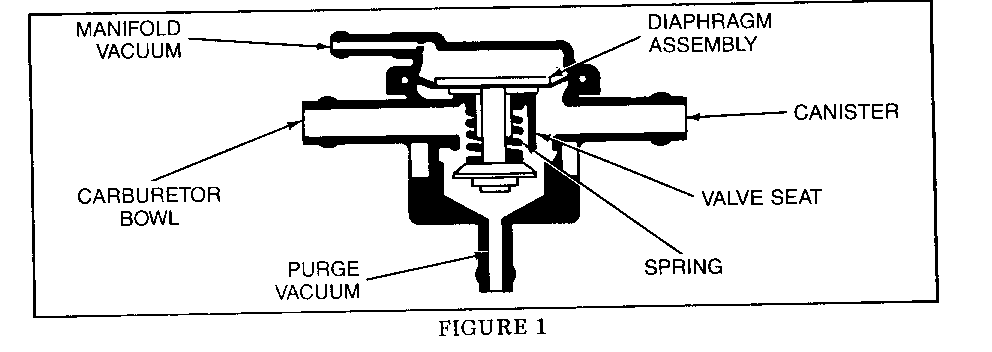For 1990-2009 cars only
CANISTER CONTROL VALVE TEST PROCEDURE

SUBJECT: TESTING REMOTE CANNISTER CONTROL VALVES ON ALL 1982-83 3.0L, 3.8L, 3.8L TURBO AND 4.1L BUICK ENGINES CODE E CODE A CODE 8 CODE 4 BEFORE A REMOTE CANNISTER CONTROL VALVE IS REPLACED, THE FOLLOWING TESTING PROCEDURE MUST BE USED TO DETERMINE IF THE VALVE HAS MALFUNCTIONED. TESTING OF THIS VALVE, (SEE FIGURE 1), IS SIMILAR TO TESTING OF A CANNISTER WITH A VAPOR VENT VALVE. APPLY A SHORT LENGTH OF HOSE TO THE VALVE'S CARBURETOR BOWL TUBE AND BLOW INTO IT, TO DETERMINE THAT AIR WILL PASS THROUGH THE VALVE ASSEMBLY AND OUT BOTH THE CANNISTER TUBE AND PURGE VALVE TUBE. IF AIR WILL NOT PASS, THE CANNISTER CONTROL VALVE MUST BE REPLACED. WITH A HAND VACUUM PUMP, APPLY VACUUM (15" HG OR 51 KPA) TO THE MANIFOLD VACUUM TUBE. THE DIAPHRAGM SHOULD HOLD VACUUM FOR AT LEAST 20 SECONDS. IF IT DOES NOT, THE DIAPHRAGM IS LEAKING, AND THE CANNISTER CONTROL VALVE MUST BE REPLACED. WITH VACUUM STILL APPLIED TO THE MANIFOLD VACUUM TUBE, AGAIN ATTEMPT TO BLOW INTO THE VALVE'S CARBURETOR BOWL TUBE. AIR SHOULD NOT PASS THROUGH EITHER THE CANNISTER TUBE OR PURGE VACUUM TUBE, INDICATING THAT THE VALVE IS SEALING PROPERLY. IF AIR DOES PASS THROUGH EITHER TUBE, THE VALVE IS NOT FUNCTIONING PROPERLY AND MUST BE REPLACED.

General Motors bulletins are intended for use by professional technicians, not a "do-it-yourselfer". They are written to inform those technicians of conditions that may occur on some vehicles, or to provide information that could assist in the proper service of a vehicle. Properly trained technicians have the equipment, tools, safety instructions and know-how to do a job properly and safely. If a condition is described, do not assume that the bulletin applies to your vehicle, or that your vehicle will have that condition. See a General Motors dealer servicing your brand of General Motors vehicle for information on whether your vehicle may benefit from the information.
